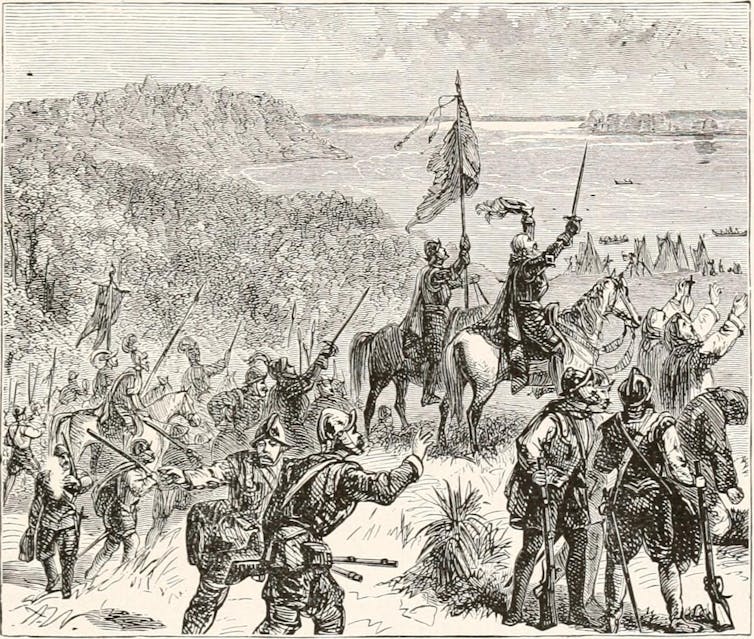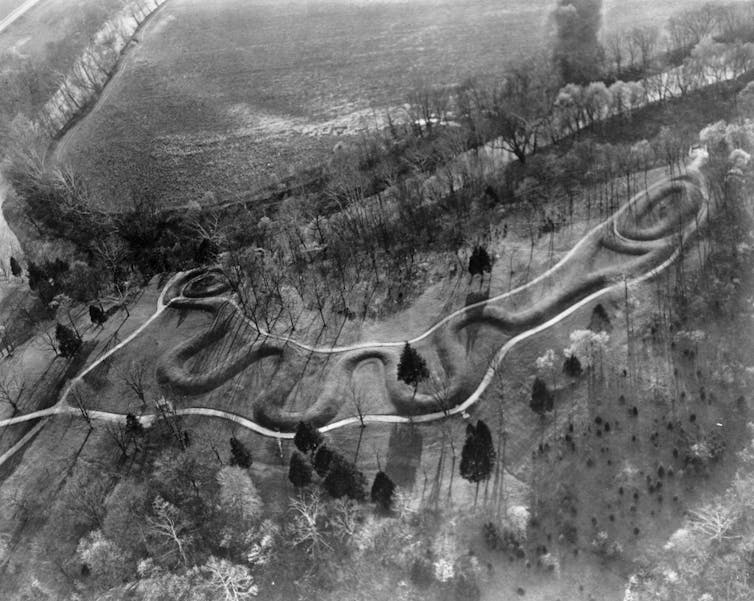The story of Ohio's ancient Native complex and its long journey for recognition as a World Heritage
An Indigenous sacred site, Hopewell Ceremonial Earthworks has served as a military barracks, a fairground and, more recently, a golf course.
Hopewell Ceremonial Earthworks in Ohio was added to UNESCO’s list of World Heritage sites on Sept. 19, 2023. The eight mound complexes that received this designation are spread across central and southern Ohio and were built between the beginning of the common era and the 12th century.
The mounds are marvels of Indigenous science and astronomy, which helped Native Americans organize everything from cycles of planting and hunting to their ritual calendar.
But two of the mound complexes, Newark and Serpent Mound, which were not controlled by either the National Park Service or the Ohio History Connection, the state’s historical society and museum, were treated poorly.
Newark has an approximately 2,000-year-old series of geometric enclosures, the largest series in the world. These enclosures include a circular mound connected by a walled road that leads to an octagon-shaped mound at the site. Physicist and astronomer Ray Hively and philosopher Robert Horn have demonstrated that “the four vertices of the octagon form a square whose sides matches the diameter of the circle.” The symmetry of the circle and octagon charts nearly perfectly the lunar nodal cycle, which takes 18.6 years to complete.
Serpent Mound lies 125 miles to the south of Newark. It is a nearly 1,400-foot-long effigy of a coiled serpent that also tracks the summer and winter solstice.
As a historian and ethnographer of the Native American Midwest, I have documented Native peoples’ commitment to their original homelands. The long journey toward this recognition tells a larger story about imperiled Native American sacred sites in the eastern half of the United States and the challenges faced by those who wish to protect them.
American settlers and Native peoples
Native nations originally from east of the Mississippi River largely lost control of their sacred sites as a result of the Indian Removal Act of 1830.
The policy resulted in the wholesale replacement of Native Americans with settlers in nearly every corner of the eastern half of the United States. Three of the Native nations that have helped win the World Heritage designation for the mounds – the Shawnee, Potawatomi and Miami Nation – were subject to removal.
In 1831, soldiers forced Shawnee villagers in northeastern Ohio to move from their land. Seven years later, the U.S. Army compelled 859 Potawatomis from northern Indiana to leave – an event, known as the “Trail of Death,” that resulted in the deaths of more than 40 of their people. And in 1846, American settlers forced the Miami Nation out of their homes along the Wabash River, in Indiana. They ultimately accepted a reservation in Oklahoma.
This policy was widespread: Only one nation, the Sac & Fox Tribe of the Mississippi in Iowa, or Meskwaki, remains headquartered in the lower Midwest.

The forced expulsion of Native nations from their homelands made it difficult for them to protect their sacred heritage. For example, the Eastern Shawnee Tribe of Oklahoma is headquartered roughly 750 miles from the Hopewell Ceremonial Earthworks, which many Shawnees and scholars believe was built by the tribe’s ancestors.
Native nations now headquartered in Oklahoma cannot provide the kind of daily protection of their sacred sites that they once did. Instead, they must rely on non-Native allies who now live on their ancestral lands.
Post-removal abuse and neglect
The Newark Earthworks and Serpent Mound illustrate the difficulty of protecting and reclaiming sacred sites for Native nations subjected to removal.
Over the years, Newark became a military barracks, a fairground, and for the past century it has been leased to the Moundbuilders Country Club. Since 1910, an 18-hole golf course has made use of the mound complex.
Ephraim Squier was the first archaeologist to study Newark, in the 1840s. At the time, most Americans believed that the Bible was the literal word of God and that white Americans were a superior race. Both beliefs shaped archaeological theory. Squier argued that the Toltecs built the mounds and then migrated to Mesoamerica, where they built the great monuments of Mexico and Guatemala. He did not believe that the Indigenous people of the United States were capable of building the mounds.
Unfortunately, some Americans continue to promote false theories about the mounds, casting doubt on the genius of Indigenous science.
Despite his misgivings, Squier nonetheless acknowledged their beauty and accuracy, writing that “the most skillful engineer of the day” would not be able to replicate the accurate dimensions of these mounds.
In the 19th century, Serpent Mound was partially destroyed by farmers. Then, in the the 20th century, two private, nonprofit corporations, Friends of Serpent Mound and Arc of Appalachia, started to manage the site.
These organizations sponsored events in which New Age groups buried crystals in Serpent Mound, lit luminaria around the base of the serpent and conducted summer and winter solstice celebrations they called Star Knowledge Peace Summits. “The crystal people and the New-Agers had taken over the place,” said one park ranger I interviewed in 2022.
Chief Glenna Wallace of the Eastern Shawnee Tribe of Oklahoma has described these practices as desecrations that were conducted without their consent. “My ancestors treasured these mounds. They were sacred. No, they did not build them but they loved them, protected them, revered them,” she wrote.
When she first visited Newark in June 2007, there was a golf tournament underway. Instead of welcoming her, she recalls golfers shouting, “Get back! You’re in the way!” as she attempted to admire her ancestors’ creation.
Collaboration and hope for the future
The fight to protect the Hopewell Ceremonial Earthworks represents more than 25 years of hard work. Citizens of Native nations who were forcibly removed to Oklahoma collaborated with Native and non-Native allies affiliated with the Newark Earthworks Center – an academic center at Ohio State University, Newark campus – and the Ohio History Connection to protect and research the mounds.

Since 2020, the Ohio History Connection, which took over management of Serpent Mound, has been doing community-engaged archaeology. As part of this engagement, staff archaeologists work with the cultural preservation officers of affiliated Native nations to interpret the site.
Similarly, the staff of the Ohio History Connection and the Newark Earthworks Center regularly consult with tribal leaders regarding the Newark Earthworks. These diverse stakeholders worked together for the World Heritage designation.
The fight over the Newark Earthworks has proved far more difficult. The golf club has a century-long lease with the state of Ohio, which the state attempted to terminate through eminent domain. In response, Moundbuilders Country Club sued the Ohio History Connection, arguing that the state of Ohio did not have the right to take private property and convert it to public use.
In May 2019, Licking County Common Pleas Court Judge David Branstool concluded that “100 years of manicured lawns does not immunize the Country Club from eminent domain.” In short, the public’s right to access and appreciate the site is more important than the right of country club members to play golf on the mounds.
In December 2022, the Moundbuilders Country Club appealed the decision to the Ohio Supreme Court and lost. Now both sides await a trial to determine how much money the Ohio History Connection must pay to the club to finally control the mound complex.
Nonetheless, there is much to celebrate now that the Hopewell Ceremonial Earthworks has been named the 25th World Heritage site in the United States. The collaborative partnership between Native nations removed from Ohio, the Ohio History Connection, the National Park Service and dedicated archaeologists in the state serves as a hopeful example of how sacred sites in the eastern half of the United States might be better protected, and interpreted, in the future.
Stephen Warren does not work for, consult, own shares in or receive funding from any company or organisation that would benefit from this article, and has disclosed no relevant affiliations beyond their academic appointment.
Read These Next
RFK Jr. wants to scrutinize the vaccine schedule – but its safety record is already decades long
Federal officials are questioning the safety of the vaccine series children receive. Here’s the story…
Deception and lies from the White House to justify a war in Venezuela? We’ve seen this movie before
Two US wars based on lies, in which tens of thousands of American troops and millions of civilians died,…
Understanding climate change in America: Skepticism, dogmatism and personal experience
Real skeptics study the evidence and ask questions, rather than taking political dogma on faith. Experiencing…






